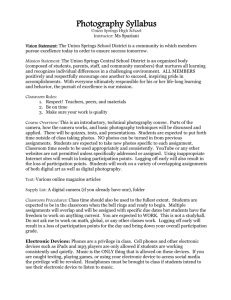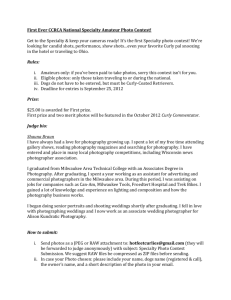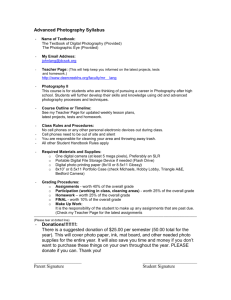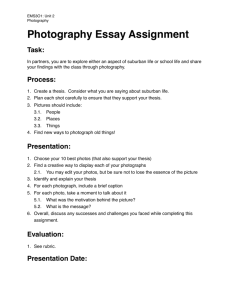MEDT 7466 Final Exam
advertisement
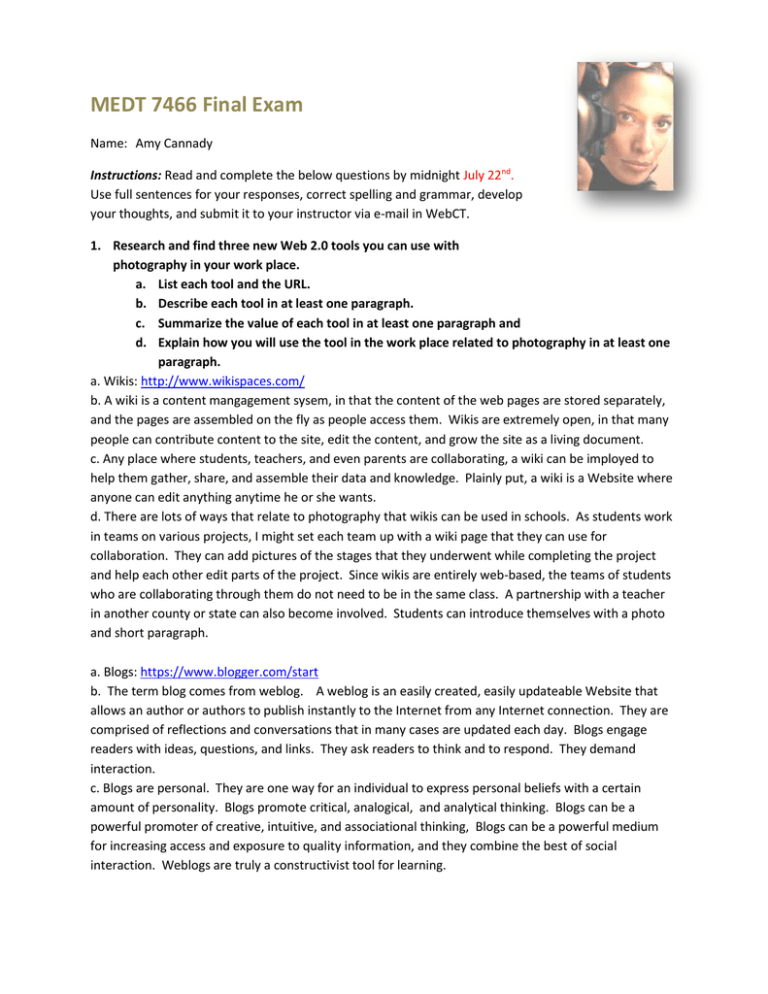
MEDT 7466 Final Exam Name: Amy Cannady Instructions: Read and complete the below questions by midnight July 22nd. Use full sentences for your responses, correct spelling and grammar, develop your thoughts, and submit it to your instructor via e-mail in WebCT. 1. Research and find three new Web 2.0 tools you can use with photography in your work place. a. List each tool and the URL. b. Describe each tool in at least one paragraph. c. Summarize the value of each tool in at least one paragraph and d. Explain how you will use the tool in the work place related to photography in at least one paragraph. a. Wikis: http://www.wikispaces.com/ b. A wiki is a content mangagement sysem, in that the content of the web pages are stored separately, and the pages are assembled on the fly as people access them. Wikis are extremely open, in that many people can contribute content to the site, edit the content, and grow the site as a living document. c. Any place where students, teachers, and even parents are collaborating, a wiki can be imployed to help them gather, share, and assemble their data and knowledge. Plainly put, a wiki is a Website where anyone can edit anything anytime he or she wants. d. There are lots of ways that relate to photography that wikis can be used in schools. As students work in teams on various projects, I might set each team up with a wiki page that they can use for collaboration. They can add pictures of the stages that they underwent while completing the project and help each other edit parts of the project. Since wikis are entirely web-based, the teams of students who are collaborating through them do not need to be in the same class. A partnership with a teacher in another county or state can also become involved. Students can introduce themselves with a photo and short paragraph. a. Blogs: https://www.blogger.com/start b. The term blog comes from weblog. A weblog is an easily created, easily updateable Website that allows an author or authors to publish instantly to the Internet from any Internet connection. They are comprised of reflections and conversations that in many cases are updated each day. Blogs engage readers with ideas, questions, and links. They ask readers to think and to respond. They demand interaction. c. Blogs are personal. They are one way for an individual to express personal beliefs with a certain amount of personality. Blogs promote critical, analogical, and analytical thinking. Blogs can be a powerful promoter of creative, intuitive, and associational thinking, Blogs can be a powerful medium for increasing access and exposure to quality information, and they combine the best of social interaction. Weblogs are truly a constructivist tool for learning. d. One trend that shows no sign of stopping is the movement of curriculum to a digital, online environment. From a teaching standpoint, having a blog to publish course curriculum, syllabus, class rules, homework assignments, rubrics, handouts, and presentations makes a Weblog a powerful course management tool. Each of the categories above could be accompanied by a digital photograph to make the blog more personable. a. Flickr: http://www.flickr.com b. Flickr is a photo publishing place on the Internet. Flickr offers some new and interesting features owing to the spirit of Web 2.0. A person can have “flickr’ed” images displayed on existing blogs and wikis. c. Flickr is one of the best phot sharing sites on the Web. The contributors interact, share, and learn form each other in creative and interesting ways. Its educational potential is huge. d. The easiest place for teachers and students to begin experimenting with creating and publishing content other than text is with digital photography. I can now include digital images in my lists of things I can create in my classroom. At times I can communicate more effectively with my students by using images. From a classroom standpoint, think about the ability to capture daily events or highlights and easily share those with parents, students, community, and colleagues. Field trips, speakers, visitors, and special projects could become a part of any classroom’s “photo stream.” 2. List photography resources that are of the greatest value to you that you discovered in this course. List 5 electronic resources and 5 print resources and explain why you selected each resource. 5 Electronic Resources 1. http://mashable.com/2007/06/23/photography-toolbox/ This website gives links to flickr, blogs, and free on-line photo tools. It gives over 90 resources and tools for the budding photographer. 2. http://www.resourcehelp.com/qserphoto.htm This site gives definitions of digital photography terms. Don’t know what a mega pixel is? Find it on this Website. Looking to buy a digital camera? Get tips from this page. 3. http://www.thefreesite.com/Free_Graphics/Free_photos/ One word: FREE. Educators love that word. This site lists the Web’s various resources for free photo image clipart resources. 4. www.flickr.com I used this site to upload and display my photos. I then shared the web address with my mom and dad who live in Wisconsin, my sister who lives in Seattle, and my other sister who lives in Sturgeon Bay, Wisconsin. They loved seeing pictures of their grandsons and nephews. I will continue to use it long after I complete this class. 5. http://www.metmuseum.org/education/er_online_links/er_ph.htm Teacher resources on how to use photography in the classroom. Ansel Adams and George Eastman are featured with links to their photographs. 5 Print Resources 1. Obermeierm, B. & Padova, T. (2008). Photoshop Elements 6 for Dummies. Hoboken, NJ: Wiley Publishing, Inc. This is a full color guide to making your photos look their best. It is a great book for beginners! 2. Rosen, M.J. & DeVries, D.L. (2005). Photography & Digital Imaging. Dubuque, IA: Kendall/Hunt Publishing Company. The class text helped me tremendously. I quick referenced the chapter on Basic Digital Image Processing, Unit 7. I will keep this text in my classroom for future reference. 3. Miotke, J. (2005). A better photoguide to Digital Photography. New York: Berkeley Books. This books helps you take the best photos you can before editing them. As a relative newbie to photography, I found this book's explanations and illustrations to be very good indeed. It is highly recommended! 4. Kim, John. (2003). 40 digital photograph techniques. Seoul, Korea: Youngjin.com, Inc. This friendly, full-color book will help you have fun with your digital camera. You'll learn to compose good shots, play with light, shoot close-ups, capture objects in motion, experiment with filters, and much more. Discover forty valuable techniques and hundreds of creativity-inspiring images, and then test out the free software on the companion CD. 5. Adams, Ansel. (1995).The camera. New York: Little, Brown & Company. This is the first volume in Adams' celebrated series of technical books on photography, and has taught generations of photographers how to harness the camera's artistic potential. 3. List and describe 5 new photography integration activities you will use in the workplace that you learned about in this class. Why do you believe each of these activities will be effective with your intended audience? a. I will take pictures of my students during the first week of school. The pictures will help me remember the students’ names. I also want them to write something on the back such as their favorite hobby, food, vacation spot. I will also use the photos to create a seating chart for me and for substitutes. The students love taking photographs of themselves in the 8th grade. b. Students in the 8th grade are learning how to put PowerPoint slides together. I think they would enjoy inserting digital pictures instead of the boring clipart. For example, I have student create a PowerPoint on a part of speech. This year, I will have them act out a part of speech. I will take pictures and the students can insert them into the presentation. c. This year, I am going to create and maintain either a wiki or blog. To motivate students to participate, I will post digital photos of them in the school environment. I will need to ask parents and the school for permission, (I’m pretty pessimistic about the school giving permission) but I think most parents will support me. d. My eighth graders love taking pictures of themselves and being competitive. I will hold, once a month, a photo contest. I will assist students in editing the photos in my room either before or after school. The winning photo will be displayed in the classroom and will be the topic of our next writing assignment. e. Students will take photos on a theme. The students could decide on a theme (isolation, conflict, honor, bravery) and then take photos based on that theme. They would then have to explain the relationship between the photographs. An alternative would be to show the photos and ask the other students to think what the theme is. This would involve a lot of interesting discussion. 8th grade students love to discuss and debate topics. 4. Explain how you will become a change agent in the schools or your work environment and try to get the administration, teachers, and students integrating photography more? What will you do to try to infuse photography more in the workplace? What challenges will you run into? How will you deal with these? Do you think you will be successful? In more and more schools today, technology is recognized as an instructional tool, not as a subject of instruction. Still, many educators, less familiar and less comfortable with technology than their students, struggle to seamlessly integrate a growing list of technology tools into their regular curriculum. I will explain to the faculty that digital cameras can be used to illustrate a variety of curricular topics, such as growing plants, changing seasons, and field trips. Digital photos can be printed, used to illustrate student writing, or included in a slide show or on a Web page. To help inform and persuade administrators, I could provide them with technology standards and provide staff development courses in integrating photography into the curriculum. No doubt, I will run into the teacher or administrator who is “set in his or her ways.” I can provide student work and parental comments on the benefits of that work to promote motivation. I will also run into the challenge of restricted web sites such as all blogging sites, wiki sites and flickr. If I plead with the district administrator and technology personnel and provide with with authentic learning experiences and student portfolios perhaps they can be persuaded. Students are coming to class with more skills. Whether a teacher requires it or not, most students prefer to use technology for their projects. 5. List and describe five ways that you believe photography can best be used to promote and advance multicultural education in the workplace? Which of these will you use next year? a. As part of study on understanding differences, I will have each student create a family mural consisting of family photos. Groups will discuss each person’s photo describing unique clothing, styles, body language and background of the photo. Murals will be displayed around the school for EVERYONE to see. b. Each student will research his or her heritage. Students will take pictures of holidays celebrated, customs, beliefs, and values. After writing an essay and sharing photographs, students will display photos around the school for EVERYONE to see. c. Each month during character education time, I will invite a speaker. Each month’s speaker will be of a different heritage. The speaker will address the class on culture and tradition. I will take pictures of the speaker and encourage students to remember what was discussed. d. Students will become e-mail pals with a person of another culture. Each person will create a daily blog journal where they write down their daily accomplishments, goals, and occurances. They will share what they ate, what time they got up, what time they went to bed, what they did, what chores they have, etc…. They will e-mail each other daily for a week and report to the class anything unique or interesting that is different from their culture. The first step is for the e-mail pals is to take a photo of themselves. Students should consider taking photos of daily happenings to help provide clarification and description. e. I will ask parents to lend me recordings of music that their family enjoys. I will teach the children songs and dances from different nations of the world. Children will begin to see that all people like to sing and dance, but every group has its own special ways of doing it. A discussion about how different music sounds: loud, soft, fast, or slow can follow. We will listen for the different instruments. It might be wise to parents if they have any instruments children could listen to or try. Photos can be taken of students dancing or singing. Of the five sample lessons probably try inviting a guest would appreciate hearing subject. 6. What shot did you want to get a chance to take in this another (e.g., it was not listed above, I will speaker. My students another voice on the take that you did not class for one reason or listed as a possibility, you did not have time to take it, you were not at the right place at the right time to take the shot). Go and take the photo now and submit it with this final exam. I did not take a self-portrait. I hate pictures of myself. I notice how fat I am. I notice the freckles and moles on my face. I notice how bad my hair looks. Maybe I Photoshop the picture to death!! 7. How has your perception of photography changed as a result of taking this course? Do you see the world differently? Why or why not? Absolutely, I see the world differently. At one time, I would look at professional photographers and their photographs in awe. Never did I think I was talented or creative enough to take “good” photos especially of my family. I love going places with my family and camera. When we get in the car, my kids and husband ask if I have the camera. It’s part of me and my family now. We are going to run out of space on the walls. My children have also expressed an interest in taking pictures. What a neat hobby for them. As a result of taking this class, I think I will be a better teacher. I can’t wait to take pictures of my students in action.

